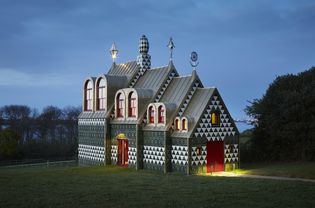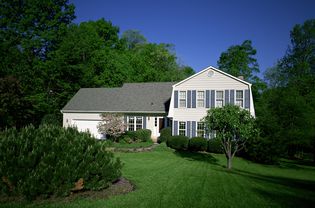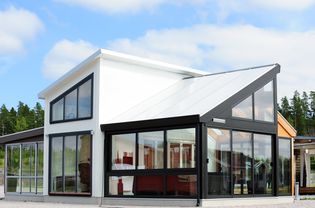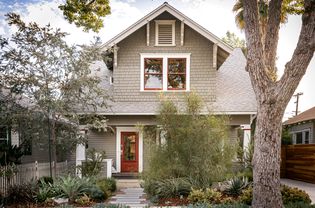The dawn of modern architecture came at a time when hand-labored craftsmanship was being replaced with machine-made industrialization. Modern architects worked to reinvent ways of building that focused more on how humans lived versus what they found beautiful. This architecture is not sentimental, like revivalist styles. Instead, it is innovative, experimental, and minimal.
What Is Modern Architecture?
Modern architecture is a style of building that emphasizes function and a streamlined form over ornamentation. This design aesthetic is a departure from more elaborate and decorated homes like Queen Anne, Victorian, or Gothic Revival styles. Modern architecture usually involves sharp, clean lines.
There are several styles of modern architecture in the United States alone. From 1930 through 1970, there are categories like Expressionist, Constructivist, and Mid-Century Modern, to name a few.
History
The modern movement was not short-lived, and it encompasses several sub-styles that span nearly 60 years. In this way, it can be difficult to pinpoint an exact starting point. To some, the style includes more transitional architecture like the Art Deco and Arts and Crafts movements. To others, those earlier styles served as inspiration for more "pure," mid-century modern architects.
The birth of modern design came with the thought that form should follow function. This idea started with architect Louis Sullivan who designed buildings for the 1893 Chicago World Fair. That mantra became the foundation for modern architects.
Other popular pioneers of modern architecture include Frank Lloyd Wright, Staatliches Bauhaus, Ludwig Mies van der Rohe, and Le Corbusier.
The modern design aesthetic was in full swing in the 1930s and became known as International Modernism or International Style. This design aesthetic came after an architecture exhibit by Philip Johnson in 1932.
In general, the most well-known examples of modern architecture end around the mid 20th century, but the design style still influences buildings well into the late 20th century.
Characteristics
Since there are so many styles of modern architecture, there are several defining characteristics. These are some of the more common, broad key features that can be seen across many different forms.
- Clean, minimal lines. These lines lack additional ornamentation and are generally a consistent, smooth texture.
- Broad roof overhangs. Several modern homes emphasize low, horizontal structures with large roof overhangs.
- Walls of glass and large windows. You will find a very generous use of glass, which allows a significant amount of natural light into the interior.
- Open and well-defined floorplans. Since modern architecture focuses on form over function, architects sought to include large, spacious floorplans with dining and living spaces that flowed into one another.
- Modern and traditional building materials. Some common materials in modern homes include steel, concrete block, iron, and glass. More conventional building materials like wood, brick, and stone were used in more straightforward ways to show off their natural beauty.
- A relationship to the outside environment. A lot of thought went into building sites and how buildings would relate to the natural landscape surrounding them.
- Asymmetrical designs. Modern architects played around with large, smooth shapes and asymmetrical compositions that were cleanly planed and lacked any additional decoration.
:max_bytes(150000):strip_icc()/modern-architecture-4797910-01-d460982f5c7a420083be54f5770dd037.jpeg)
The Spruce / Sarah Crowley
:max_bytes(150000):strip_icc()/modern-architecture-4797910-03-62cbfa12993e45efa659d687f7b29e7b.jpg)
The Spruce / Sarah Crowley
:max_bytes(150000):strip_icc()/modern-architecture-4797910-04-616712b4f2dd4975bb670092d4b6afef.jpg)
The Spruce / Sarah Crowley
Interesting Facts
The most common theme is the elimination of ornaments.
Earlier styles of modern architecture still had some use of ornamentation. For instance, Frank Lloyd Wright would incorporate art glass windows so that no additional artwork was needed. Beyond that, modern architecture is mostly analytical and not showy.
Modern architecture is different than contemporary architecture.
To some people, modern and contemporary architecture are the same thing. However, modern architecture was inspired by an art movement known as modernism and lasted until around 1960. Contemporary architecture incorporates architecture past the 1960s and leading up to today. In short, contemporary architecture is reflective of styles in this current moment, which happen to be very diverse.
Eventually, modern homes seemed too cold for everyday living.
Modern homes were revolutionary in that they embraced the concept of free-flowing space. The ideology also rejected clutter and excess belongings. However, as the design period went on, many architects challenged this strict notion of space and lack of stuff as cold and impersonal. This evolution brought on more contemporary designs that worked to incorporate ornamentation and color. In contemporary homes, you can have an open concept floor plan but also have an element of privacy.
In summary, modern architecture began in the early 1900s and ended around the 1960s when more contemporary designs took over. The basic principles of modern architecture include form following function, clean lines, and a lack of ornamentation. Eventually, modern principles became too cold for everyday living due to an excess of space and the stark nature of the building materials.
:max_bytes(150000):strip_icc()/thomann-headshot-1-aeaaee90f25846f59d414f1311b7d385.jpg)
:max_bytes(150000):strip_icc()/NewheadshotJW-931b8aadf3d540ccb600a4d03b1276a9.jpg)
:max_bytes(150000):strip_icc()/modern-architecture-4797910-hero-5c5186edf45641e5be01b6940d3d2fd6.jpg)








